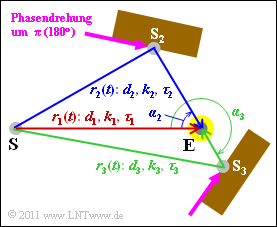Exercise 2.5Z: Multi-Path Scenario
In Exercise 2.5, a delay–Doppler function (or scatter function) was given. From this, we will calculate and interpret the other system functions. The given scatter function s(τ0,fD) was
- s(τ0,fD)=1√2⋅δ(τ0)⋅δ(fD−100Hz) −
- − 12⋅δ(τ0−1μs)⋅δ(fD−50Hz) −12⋅δ(τ0−1μs)⋅δ(fD+50Hz).
Note: In our learning tutorial, s(τ0,fD) is also identified with ηVD(τ0,fD) .
Here we have replaced the delay variable τ with τ0 . The new variable τ0 describes the difference between the delay of a path and the delay τ1 of the main path. The main path is thus identified in the above equation by τ0=0 .
Now, we try to find a mobile radio scenario in which this scatter function would actually occur. The basic structure is sketched above as a top view, and the following hold:
- A single frequency is transmitted fS=2 GHz.
- The mobile receiver (E) is represented here by a yellow dot. It is not known whether the vehicle is stationary, moving towards the transmitter (S) or moving away from it.
- The signal reaches the receiver via a main path (red) and two secondary paths (blue and green). Reflections from the obstacles cause phase shifts of π.
- S2 and S3 are to be understood here as fictitious transmitters from whose position the angles of incidence α2 and α3 of the secondary paths can be determined.
- Let the signal frequency be fS, the angle of incidence α, the velocity v and the velocity of light c=3⋅108 m/s. Then, the Doppler frequency is
- fD=v/c⋅fS⋅cos(α).
- The damping factors k1, k2 and k3 are inversely proportional to the path lengths d1, d2 and d3. This corresponds to the path loss exponent γ=2.
- This means: The signal power decreases quadratically with distance d and accordingly the signal amplitude decreases linearly with d.
Notes:
- This task belongs to chapter Das GWSSUS–Kanalmodell.
- We focus especially on the path-loss model and the Doppler effect.
Questionnaire
Sample solution
(2) The equation for the Doppler frequency is
- fD=vc⋅fS⋅cos(α),
If the angle of incidence is α=0, the Doppler frequency is
- fd=vc⋅fS
- The speed of the receiver is then
- v=fDfS⋅c=102Hz2⋅109Hz⋅3⋅108m/s=15m/s=54km/h_.
(3) Solutions 1 and 4 are correct:
- The Doppler frequency fD=50 Hz comes from the blue path, because the receiver moves towards the virtual transmitter S2 (i.e., towards the reflection point), although not directly. In other words, the movement of the receiver reduces the blue path's length.
- The angle α2 between the direction of movement and the connecting line S2–E is 60∘:
- cos(α2)=fDfS⋅cv=50Hz⋅3⋅108m/s2⋅109Hz⋅15m/s=0.5⇒α2=60∘_.
(4) Statements 1 and 3 are correct:
- From fD=–50 Hz follows α3=α2±π, so α3 =240∘_.
(5) All statements are correct:
- The two Dirac functions at ±50 Hz have the same delay. We have τ3=τ2=τ1+τ0.
- From the equality of the delays, however, also follows that d3=d2. As both paths have the same length, their damping factors are also equal.
(6) The delay difference is τ0=1 µs, as shown in the equation for s(τ0,fD).
- This gives the difference in length:
- Δd=τ0⋅c=10–6s⋅3⋅108 m/s =300 m_.
(7) The path loss exponent was assumed to be γ=2 for this task.
- Then k1=K/d1 and k2=K/d2.
- The minus sign takes into account the 180∘ phase rotation on the secondary paths.
- From the weights of the Dirac functions one can read k1=√0.5 and k2=−0.5. From this follows:
- d2d1=k1−k2=1/√20.5=√2=1.414_.
- The constant K is only an auxiliary variable that does not need to be considered further.
(8) From d2/d1=2−0.5 and Δd=d2−d1=300 m finally follows:
- √2⋅d1−d1=300m⇒d1=300m√2−1=724m_⇒d2=√2⋅d1=1024m_.
